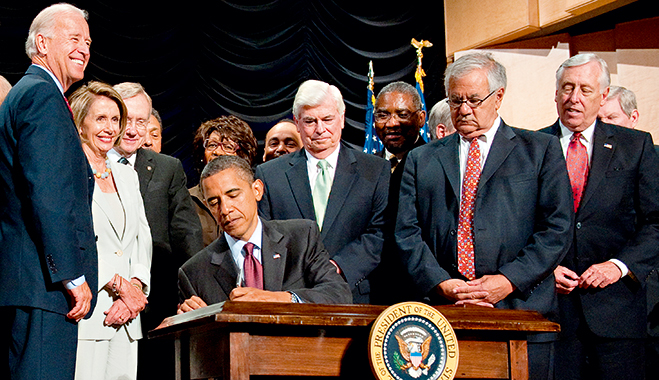
Since 2008, the regulation of banks can be measured by the value of fines levied against them. By latest estimates, total financial penalties could reach $250bn by 2020. But the fines tell a bigger story, as regulators now believe they are on the brink of taming the giant banks once and for all
2009
Horrified at the mayhem bankers had left behind while still pocketing bonuses that would keep Midas happy, regulators set about addressing what they called ‘imprudent remuneration’. Though it took a while, results were eventually seen – particularly in Europe. For example, the UK banned the payment of bonuses for three years, and regulators clawed them back for up to seven years in cases of misconduct and/or
bad management.
2010
President Barack Obama signs into law the biggest overhaul of Wall Street since the Great Depression of the 1930s. Coming in at 848 pages, its full title is the Dodd-Frank Wall Street Reform and Consumer Protection Act, and it lands with a crash on the desks of the US’ financial sector chief executives. Those executives had been spending $1m a day on lobbyists to try and convince congress this door-stopper wasn’t needed, but to no avail.
2011
The Bank for International Settlements begins working on new prudential standards during many late-night sessions in Basel, Switzerland. Created to serve central banks in their pursuit of financial stability, it orders giant international firms to beef up their capital – and to do so in a hurry. It seems the boffins in Basel were just in time. Judged by the safer prudential requirements, central banks had an alarming collective shortfall in aggregate capital of $142.5bn.
2012
In the US, the implementation of the so-called Volcker Rule turns into a nightmare. Introduced late in the piece by the Dodd-Frank lawmakers, it is the brainchild of Paul Volcker, former head of the US Federal Reserve, who believed government-insured, deposit-taking banks should not also run high-risk investment divisions – proprietary trading – at the taxpayers’ expense. The cost to US banks of implementing the rule is up to $10bn a year.
2013
Since being ordered to put more money in the vault, the big boys of the banking world have raised a staggering $123.7bn in new capital. These institutions now held between seven and 10 times more capital than they had before the crisis. However, in the meantime, many businesses (particularly in Europe) have been starved of credit, and the eurozone enters recession. This causes conflict between companies wanting to up their credit.
Early 2014
The Bank of England finalises work on a simple leverage ratio for all those financial institutions that came under its wing. Although the ratios vary, no regulated lender would ever again be able to engage in brinkmanship: no longer would they be allowed to leverge 40 to 50 dollars for every depositor’s dollar. It is hoped this will keep the industry out of severe danger. Other countries are expected to follow suit over the next few years.
October 2014
Some bankers never learn. Just two years after global regulators cracked the LIBOR-rigging racket, six banks are fined a total of $3.3bn for further misconduct in the foreign exchange markets. As the Bank of England’s Governor Mark Carney scathingly pointed out, this was no longer about a few bad apples: “The issue is with the barrels in which they are stored.” He warns bankers they should give up more of their pay in cases of wrongdoing.
November 2014
The latest G20 leaders’ summit in Brisbane puts the finishing touches on a furious five years of regulation. Mark Carney explains: “The system is safer, simpler and fairer.” The final breakthrough comes in proposals that will allow ‘globally systemic’ banks to collapse without consuming taxpayers’ funds, or bringing the whole financial system down on our heads. But it will still be a long time before regulators are able to trust banks again.


